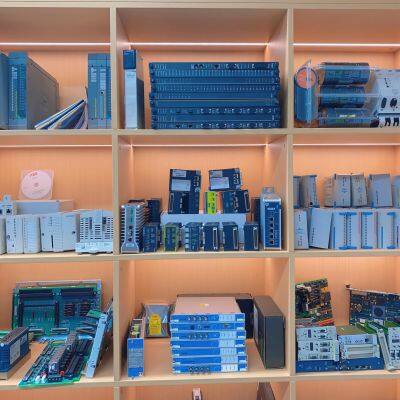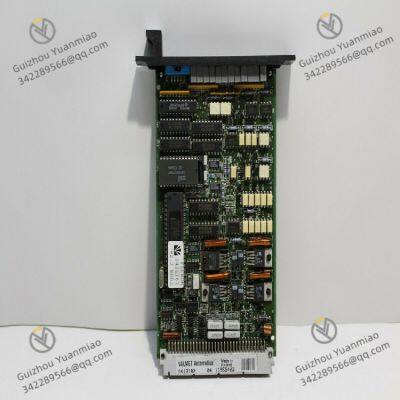Product Description
I. Overview
Metso A413182 is a multi-channel industrial control module, whose core positioning is to provide a full-link solution of "real-time signal acquisition - dynamic logic operation - safe execution control" for oil-immersed equipment, heavy machinery, and complex process industries. As a key component of Metso's automation systems (such as Metso DNA DCS and Metso Outotec equipment control systems), its essence lies in realizing accurate processing of multiple types of on-site signals (including analog, digital, and pulse signals), dynamic adjustment of equipment operating parameters, and millisecond-level response to fault states through a high-reliability hardware architecture and programmable control algorithms. It is particularly suitable for harsh industrial environments with high vibration, heavy dust, and strong electromagnetic interference (e.g., mine crushing workshops, areas adjacent to cement rotary kilns, and metallurgical rolling mill systems).
Adopting a fanless and compact design, it is compatible with the input and output of multiple signal types including analog, digital, and pulse signals, and supports seamless connection with Metso's dedicated sensors (such as vibration sensors and temperature transmitters), actuators (such as control valves and frequency converters), and third-party industrial equipment. Its integrated fault self-diagnosis function and redundant communication design can effectively reduce the risk of unplanned equipment downtime; when used with Metso's dedicated configuration software, it can realize custom control logic and multi-parameter cascade adjustment, forming a complete control closed loop covering "perception - control - monitoring - diagnosis". Whether it is the speed-load coordinated control of mine belt conveyors, the temperature-feeding amount cascade adjustment of cement kilns, or the pressure-roll gap interlock protection of metallurgical rolling mills, the A413043 can improve production efficiency and equipment reliability through precise control and stable operation, making it a core component for process industries to achieve automation upgrades.

II. Technical Parameters
(I) Signal Input/Output Parameters
Input Channel Configuration
Analog Input (AI): Supports 8 independent analog input channels, compatible with standard industrial signals of 4-20mA DC and 0-10V DC. The input impedance is ≥10MΩ (for voltage signals) and 250Ω (for current signals). It can be directly connected to on-site instruments such as pressure sensors, temperature transmitters, and level gauges, with a measurement accuracy of ±0.1% FS, ensuring accurate acquisition of weak signals (e.g., 0.1mA-level current changes).
Digital Input (DI): Equipped with 16 isolated digital input channels, supporting 24V DC signals. The input response time is ≤1ms, suitable for status signals from devices like proximity switches, limit switches, and emergency stop buttons. The anti-interference voltage is ≥250V AC (for 1 minute), preventing false triggers caused by electromagnetic interference (e.g., start/stop of frequency converters) in industrial sites.
Pulse Input (PI): Features 4 high-speed pulse input channels, supporting 0-20kHz pulse signals. It can be connected to rotary encoders (such as belt conveyor speed encoders) for the measurement and control of parameters like rotational speed and flow rate, with a pulse counting accuracy of ±1 pulse.
Output Channel Configuration
Analog Output (AO): Provides 6 analog output channels, optional for 4-20mA DC or 0-10V DC signals. The output accuracy is ±0.2% FS, with a load capacity of ≤500Ω (for current output) and ≥1kΩ (for voltage output). It can directly drive executive components such as control valves, frequency converters, and servo motors to achieve continuous adjustment control (e.g., stepless adjustment of valve opening from 0 to 100%).
Digital Output (DO): Has 8 relay output channels, each with a rated load current of 5A@250V AC / 10A@30V DC. It supports configurable normally open/normally closed contacts, meeting the on-off control requirements of devices such as contactors, indicator lights, and solenoid valves. The mechanical life is ≥10 million cycles, and the electrical life is ≥100,000 cycles (under rated load).
(II) Electrical and Performance Parameters
Power Supply and Power Consumption
Supply Voltage: 24V DC (with ±15% fluctuation tolerance), compatible with commonly used industrial DC power modules (e.g., 24V/10A switching power supplies), eliminating the need for dedicated power supply equipment.
Standby Power Consumption: ≤5W; Power consumption under full load: ≤15W. The low-power design reduces the overall energy consumption of the system, making it suitable for emergency control scenarios with battery backup (e.g., underground mine emergency systems).
Processing Performance
Control Cycle: The minimum control cycle is 10ms, supporting multi-task parallel processing. It can run 8 independent control loops (such as PID adjustment, logic interlocking, and pulse counting) simultaneously, meeting the real-time control requirements of complex processes (e.g., four-parameter coordinated control of "temperature - pressure - feeding amount - flow rate" for cement kilns).
PID Function: Built-in standard PID control algorithm, supporting online adjustment of proportional (P), integral (I), and derivative (D) parameters. It has functions such as automatic/manual bumpless transfer, anti-integral windup, and alarm interlocking, suitable for closed-loop control of continuous process parameters like temperature, pressure, and flow rate, with a control steady-state error of ≤±0.5% FS.
(III) Environmental and Compatibility Parameters
Environmental Adaptability
Operating Temperature: -20℃~+60℃, humidity 5%~95% RH (no condensation). It can operate stably in environments such as underground mines (high temperature and humidity) and metallurgical workshops (high dust and temperature) without additional temperature control devices.
Protection Level: IP20 (module itself); when used with Metso's dedicated sealed enclosure, it can be upgraded to IP54, effectively isolating dust and moisture (e.g., dusty environments of cement production lines) and adapting to dusty and humid industrial scenarios.
Anti-interference and Anti-vibration: Complies with IEC 61000-4-2 (ESD ±15kV air discharge) and IEC 61000-4-3 (radiated immunity 10V/m) standards. It can withstand mechanical vibration of 10-500Hz (acceleration 2g), ensuring stable signals in the vibration environment of heavy-duty equipment (e.g., crushers, rolling mills).
System Compatibility
Controller Adaptability: Natively compatible with Metso DNA DCS and Metso Outotec equipment control systems. It communicates with the upper computer via RS485 (Modbus RTU protocol) and Ethernet (Profinet protocol), supporting remote parameter configuration and status monitoring (e.g., remote modification of PID parameters, checking channel status).
Expansion Capability: Supports multi-module cascading (up to 16 units). The input and output channels can be expanded through bus expansion, adapting to the centralized management and control needs of multiple devices in large-scale production lines (e.g., mine crushing-conveying-screening combined systems) and reducing spare parts inventory costs.
III. Functional Features
(I) High-Reliability Design for Harsh Industrial Environments
At the hardware level, it adopts military-grade components (such as high-precision operational amplifiers and industrial-grade relays) and an isolated circuit design. The digital input/output and analog input channels are all equipped with photoelectric isolation functions to block the impact of ground loops and electromagnetic interference (e.g., high-frequency interference generated by frequency converters) on signals; at the software level, a real-time fault monitoring algorithm is built-in, which can continuously perform self-tests on the module's power supply, communication links, and channel status. The fault identification accuracy is ≥99%, and detailed fault logs (e.g., "E03: AI2 channel signal out of range") are generated. For example, in mine crushing workshops, where high dust and heavy equipment vibration place high demands on the stability of control modules, the A413043 can achieve continuous trouble-free operation with its anti-vibration (2g acceleration) and anti-interference design, with a Mean Time Between Failures (MTBF) of ≥80,000 hours, reducing the frequency of shutdown maintenance.
(II) Multi-Type Signal Processing for Complex Process Control
It supports the synchronous processing of multiple signal types (analog, digital, and pulse signals) and can realize logical interlocking and control across signal types. For instance, in the control of cement rotary kilns, the module collects kiln head temperature (4-20mA), precalciner pressure (4-20mA), and cooler outlet temperature (4-20mA) signals through AI channels, and feeding machine speed pulse signals and kiln speed pulse signals through PI channels. After logical operation, it adjusts the coal injection amount (4-20mA) and cooler fan speed (4-20mA) through AO channels, and controls the start/stop of the feeding machine and the opening/closing of the kiln door through DO channels, forming multi-parameter coordinated control of "temperature - pressure - speed - flow rate" and avoiding product quality issues caused by fluctuations in the thermal parameters of the kiln system. In addition, the pulse input channel supports rotational speed calculation (e.g., converting the number of encoder pulses to belt conveyor speed), which can be directly used for speed closed-loop control without additional counting modules.
(III) Flexible Control Logic and Interlocking for Production Safety
It has built-in rich control logic and interlocking functions, supporting the customization of control programs through Metso's configuration software (e.g., Metso DNA Configuration Studio): It can implement triple interlocking logic such as "high temperature (AI1) + high pressure (AI2) + low flow rate (AI3) → valve closure (DO1) + audible and visual alarm (DO2) + emergency shutdown (DO3)", and can also be configured with multi-loop PID cascade control (e.g., precalciner temperature-feeding amount-fan speed cascade adjustment for cement kilns, where the main loop controls temperature, the secondary loop controls feeding amount, and the tertiary loop controls fan speed). In the control of chemical reactors, the module can collect reaction temperature, pressure, and level signals through AI channels, adjust the opening of the cooling water valve and feed flow rate through AO channels after PID calculation, and simultaneously link DO channels to control the start/stop of the feed pump. When the temperature exceeds the limit (AI1>300℃), the pressure exceeds the limit (AI2>5MPa), or the level exceeds the limit (AI3>90%), it immediately triggers an emergency shutdown interlock to cut off the feed and heating sources, preventing the reaction from getting out of control.
(IV) Convenient Operation, Maintenance, and Status Monitoring for Reduced Management Costs
The module panel is equipped with 8 AI indicator lights (green), 16 DI indicator lights (yellow), 4 PI indicator lights (purple), 6 AO indicator lights (blue), 8 DO indicator lights (red), and 1 power indicator light (orange), allowing for intuitive judgment of the working status of each channel (e.g., a blinking AI indicator light indicates that the signal is out of range, and a steady-on PI indicator light indicates normal pulse collection); through the Ethernet interface, real-time values of each input and output, PID parameters, fault codes, and other information can be read on the upper computer (e.g., Metso DNA Operator Station), supporting historical data storage (1 year of trend data) and fault tracing. In addition, it supports online firmware upgrading, and the upgrading process does not interrupt the control function (e.g., remote upgrading via Profinet), ensuring production continuity; the module is installed on a DIN rail, and there is no need to disassemble the entire set of circuits when replacing it. The replacement time for a single module is ≤15 minutes, reducing the downtime of the production line.

IV. Application Scenarios
(I) Mining Industry: Crushing-Conveying-Screening Combined Control System
In the crushing-conveying-screening combined production system of metal mines, the A413182 plays a core control role:
Signal Acquisition: 8 AI channels are respectively connected to the jaw crusher bearing temperature (4-20mA), cone crusher hydraulic pressure (4-20mA), belt conveyor tension (4-20mA), screener vibration intensity (4-20mA), silo level (4-20mA), motor current (4-20mA), lubricating oil temperature (4-20mA), and ambient temperature (4-20mA); 16 DI channels are connected to deviation switches, pull-cord emergency stops, motor overloads, valve statuses, equipment operation feedback, and other signals; 4 PI channels are connected to belt speed encoders (0-20kHz), screener speed encoders (0-20kHz), feeder speed encoders (0-20kHz), and crusher speed encoders (0-20kHz).
Logic Control: Through the configuration software, control logic such as "belt speed <1m/s (PI1) → feeder deceleration (AO1)", "crusher bearing temperature >80℃ (AI1) → shutdown (DO1)", and "silo level >90% (AI5) → stop feeding (DO2)" is configured to prevent equipment overload or damage.
Interlock Protection: When the DI channel detects signals such as severe belt deviation (DI1), pull-cord emergency stop (DI16), or motor overload (DI3), the module immediately triggers the DO channel to cut off the power supply of the crusher, feeder, and screener (DO1/DO2/DO3), activate the braking device (DO4), and simultaneously upload fault information to the mine dispatch center via Ethernet to ensure equipment and personal safety.
(II) Building Materials Industry: Full-Process Thermal Control of Cement Kilns
In the full-process thermal control system of cement rotary kilns, the application value of the module is significant:
Multi-Parameter Acquisition and Control: AI channels collect kiln head temperature (AI1, 4-20mA corresponding to 0-1300℃), precalciner pressure (AI2, 4-20mA corresponding to -500~500Pa), cooler outlet temperature (AI3, 4-20mA corresponding to 0-400℃), raw material feed flow rate (AI4, 4-20mA corresponding to 0-100t/h), pulverized coal flow rate (AI5, 4-20mA corresponding to 0-50t/h), and kiln tail CO concentration (AI6, 4-20mA corresponding to 0-5000ppm); PI channels collect kiln speed encoders (PI1, 0-20kHz) and feeder speed encoders (PI2, 0-20kHz); AO channels adjust kiln head coal injection amount (AO1), precalciner coal injection amount (AO2), cooler fan speed (AO3), raw material feeding amount (AO4), kiln speed (AO5), and exhaust fan speed (AO6).
PID Cascade Control: Configure the precalciner temperature (AI2)-feeding amount (AO2)-fan speed (AO6) cascade control. The main loop adjusts the feeding amount set value according to the temperature deviation, the secondary loop adjusts the coal injection valve opening according to the feeding amount deviation, and the tertiary loop adjusts the exhaust fan speed according to the feeding amount and temperature deviation, with a control accuracy of ±5℃, avoiding incomplete raw material decomposition caused by precalciner temperature fluctuations.
Fault Response: When the kiln head temperature exceeds 1300℃ (AI1 is out of range), the precalciner pressure exceeds 500Pa (AI2 is out of range), or the CO concentration exceeds 5000ppm (AI6 is out of range), the module immediately closes the coal injection valves (DO1/DO2), turns on the cooling fan (DO3), and stops the feeder (DO4) through the DO channel, while uploading alarm information to the DCS to prevent kiln lining burnout or CO explosion risks.
(III) Metallurgical Industry: Rolling Mill Control System for Hot-Rolled Steel Plate Production Lines
In the main rolling mill control system of hot-rolled steel plate production lines, the A413043 realizes the following functions:
Rolling Mill Parameter Control: AI channels collect work roll temperature (AI1, 4-20mA corresponding to 0-500℃), backup roll hydraulic pressure (AI2, 4-20mA corresponding to 0-50MPa), steel plate thickness (AI3, 4-20mA corresponding to 0-50mm), steel plate temperature (AI4, 4-20mA corresponding to 0-1200℃), rolling speed (AI5, 4-20mA corresponding to 0-10m/s), and lubricating oil pressure (AI6, 4-20mA corresponding to 0-10MPa); PI channels are connected to work roll speed encoders (PI1, 0-20kHz), backup roll speed encoders (PI2, 0-20kHz), and steel plate length encoders (PI3, 0-20kHz); AO channels adjust work roll cooling water amount (AO1), backup roll hydraulic pressure (AO2), rolling speed (AO3), roll gap (AO4), lubricating oil flow rate (AO5), and steel plate straightening force (AO6).
Pressure-Thickness Interlock Protection: When the backup roll hydraulic pressure exceeds 50MPa (AI2>50MPa) or the steel plate thickness deviation exceeds ±0.1mm (AI3 deviation is out of range), the DO channel immediately stops the rolling mill operation (DO1), triggers an emergency stop (DO2), and at the same time, the AO channel adjusts the roll gap (AO4) to a safe value to avoid rolling mill overload or steel plate scrapping.
Data Upload: Upload data such as rolling mill temperature, pressure, speed, and steel plate thickness to the workshop MES system via the Profinet protocol, realizing visual management of the production process and product quality tracing.


Metso Valmet A413040 DCU Board
Metso Valmet A413046 PLC Board
Metso Valmet A413062 DMU Unit V.07
Metso Valmet A413230 ECU Ethernet Connection Unit
Metso A413665 Control Module
Metso A413381 SCSI Unit 2 x HDD NEW
Metso Valmet A413152 Control Module
Metso Valmet A413125 AIU-8 Analog Input Module
Metso Valmet A413045 Ver.05 CPU NEW
Metso Valmet A413095 GDU Module
Metso Valmet A413216 Power Module
Metso Valmet A413273 IO Rack
 yezi
Hi there! Welcome to my shop. Let me know if you have any questions.
yezi
Hi there! Welcome to my shop. Let me know if you have any questions.




